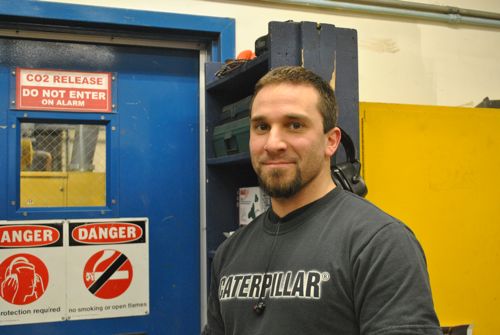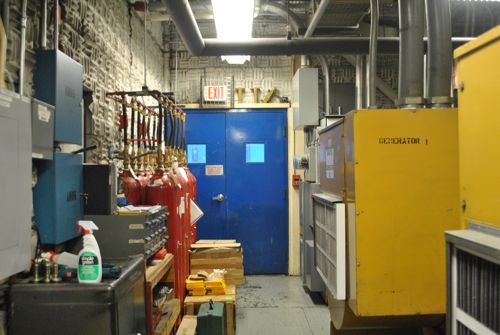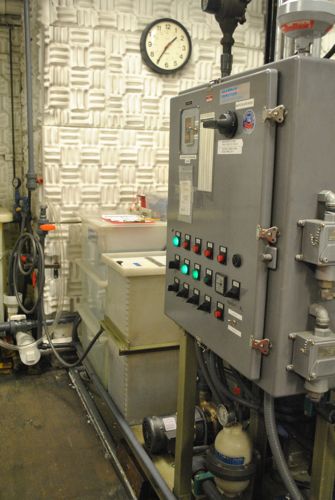Some of my students have asked how we get electricity way down here on the ice, obviously recognizing that we are pretty secluded with no power plants around. So we make our own. There is a power plant with two diesel generators that keeps this place lit up, heated, and ventilated. And we make our own fresh water too, which you probably figured out.
 Here is Anthony Andrade. Our tour guide and, more importantly, Power Plant Mechanic at Palmer Station.
Here is Anthony Andrade. Our tour guide and, more importantly, Power Plant Mechanic at Palmer Station.
Two questions may come to your mind - what is a generator and what is diesel? Or maybe that didn't come to your mind. Either way, I'm going to tell you a little bit about it. In simple terms a diesel generator is a diesel engine (an engine powered by diesel fuel, there are cars and trucks that are powered this way) that also has an electrical generator. In cities, electricity is generated by huge power grids and your home is lit up this way. When you are not connected to a grid you have to generate your own electricity. Many places have these types of generators as a back up system.
 Power Plant room. The generators and water filtration system are located here. You probably were expecting a much bigger room. Palmer is a small community. Only about 40 people or so.
Power Plant room. The generators and water filtration system are located here. You probably were expecting a much bigger room. Palmer is a small community. Only about 40 people or so.
 Here is one of the two diesel generators on station
Here is one of the two diesel generators on station
 These are the control panels for the generators.
These are the control panels for the generators.
Diesel fuel is different from gasoline in the way it ignites. In gas, the fuel and air mix, the piston compresses the air and gets ignited by the sparks in the aptly named spark plugs. Diesel works a little differently in that the air is compressed first then the fuel comes in. So why does it ignite? As the air is compressed it gets hotter and the fuel, which is loaded with potential energy and ready to interact with those oxygen molecules, combusts. Okay quick, is this an exothermic or endothermic reaction? Exo of course! You probably won't be surprised to hear that the fellow who hypothesized that a higher compression of air would lead to a higher fuel efficiency was named Rudolf Diesel. Makes sense if you think about it. Compare it to a room full of people. The more people packed in a room, the more likely you are to interact with someone. Well, molecules too. The more oxygen molecules packed into a space the more opportunity that fuel will have to react with one of them. Whoa, let's get back to Palmer Power.
 Hey, the lights are on! Everything seems to be working.
Hey, the lights are on! Everything seems to be working.
Palmer has two diesel generators. Hey, now this makes a little more sense than the first time I said it. A little background knowledge goes a long way. Each generator is 250 kilowatts each. Kilowatt is a measure of energy. More precisely, a watt, named after James Watt. Your light bulbs at home are probably 60, 75, or 100 watts. A kilowatt is a thousand watts. In an average home with everything on, assuming there is a washer, dryer, refrigerator, etc., would be around 10-15 kilowatts just to give you an idea. Only one of these generators runs at a time. Palmer gets a delivery of 60,000 gallons twice a year. The generators go through about 15 gallons an hour, give or take a few. There are two major buildings on station (not counting Terra Lab) where most of the activity takes place - science, living quarters, kitchen, offices, power and water plants, etc.) The waste heat from the generators is run through a heat exchanger and is used to heat the entire building that it is located in, GWR building (Garage, Warehouse, Recreation). In fact, more heat is generated than can be used. They are working on a plan to heat the Bio building with this also.
 Water filtration system at Palmer Station. You can see the intake tanks and control panel.
Water filtration system at Palmer Station. You can see the intake tanks and control panel.
 This might not look too interesting but these are very important to us. The larger blue cylinder on the left (there are two) filter out the bigger stuff that comes through the intake system. The four, long blue tubes are the chemical membrane filters that purify the water. They cannot be frozen or they will be no good.
This might not look too interesting but these are very important to us. The larger blue cylinder on the left (there are two) filter out the bigger stuff that comes through the intake system. The four, long blue tubes are the chemical membrane filters that purify the water. They cannot be frozen or they will be no good.
The water plant right here on station creates fresh water through reverse osmosis. You should remember from science class (or you will) that molecules go from an area of high concentration to lower concentration. What happens when you spray something on one side of the room? Pretty soon someone a little further away will smell it, right? The molecules naturally spread out - they go from high concentration to low concentration. Osmosis, the movement/diffusion of water across a membrane, will go tend toward an equilibrium and go from higher concentration to lower concentration. Knowing this, you can probably figure out what 'Reverse Osmosis' means now. Pressure needs to be applied to make the water go the other way. I wouldn't go so far as to say backwards, but it isn't following the natural flow from high to low. In the water plant here high pressure, 600 psi, is applied and the water goes through a series of membrane filters. psi stands for pounds per square inch, so 600 pounds per square inch is high pressure, don't you think? The system takes in the seawater, filters it, then sends it off to us to drink, cook, and shower. The station takes in about 600,000 gallons of seawater a week. Anthony told me it takes about 13-14,000 gallons of seawater to make about 9,000 gallons of fresh water. Where do you think those 4-5,000 gallons of water go? Good project to try to figure out. Oh boy, all this talking has made me thirsty. I need a drink of water...let's see salt or no salt...hmmmm.
 Here's a shot of of Palmer Station. Devin Devor took this great shot. You've seen him in earlier blogs. He's a grad student working on the icefish with Kristin and Lisa.
Here's a shot of of Palmer Station. Devin Devor took this great shot. You've seen him in earlier blogs. He's a grad student working on the icefish with Kristin and Lisa.
